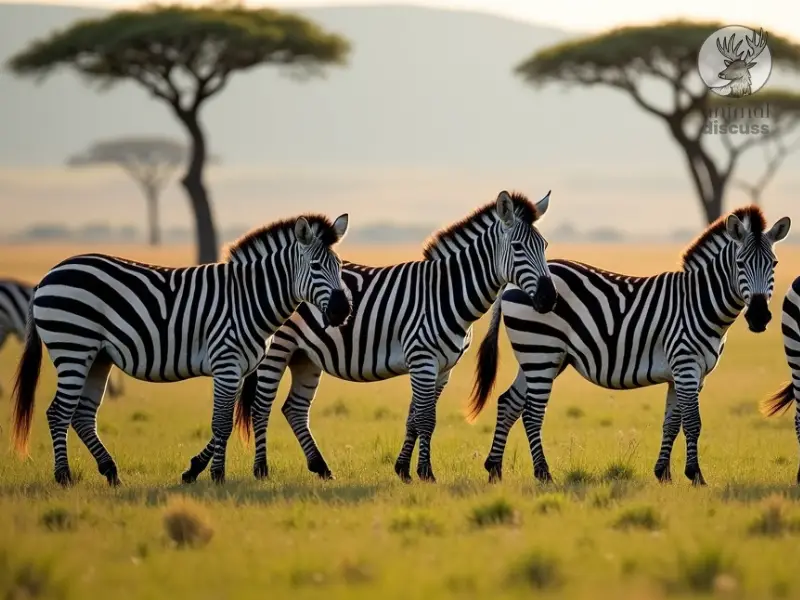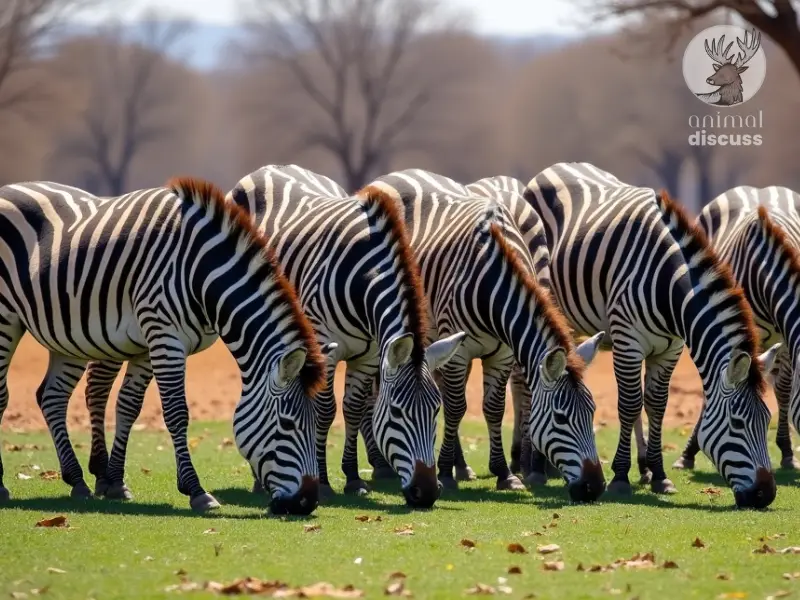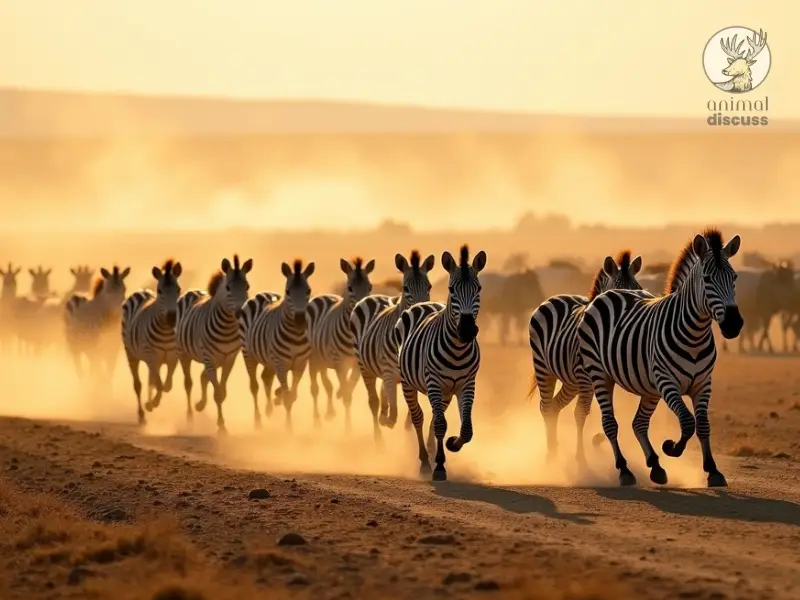This is a comprehensive guide to understanding zebra behavior.
In this guide, you’ll uncover:
- Social structures within zebra herds
- Effective communication methods among zebras
- Unique feeding behaviors and dietary habits
- Mating rituals and reproductive strategies
- Migration patterns and movement behaviors
- Defense mechanisms against predators
- The impact of environmental changes on zebra behavior
- Conservation efforts aimed at protecting their natural habits
So, if you’re eager to learn how zebras thrive in their environments and the intricate behaviors that ensure their survival, you’re in the right place!
For basics on zebra species, habitat, and traits, see our Zebra Overview article.
Social Structure of Zebras
Zebras are highly social animals that live in herds, which can consist of up to 20 individuals or even more during migration.
The social structure within these herds is complex and essential for survival.
Hierarchical Dynamics
The dominance hierarchy within a herd is primarily matriarchal, meaning that older, more experienced females often lead the group.
Dominant males play a significant role in protecting the herd and ensuring the safety of the young.

Leadership: The lead mare usually makes decisions regarding movements and feeding locations.
Other members of the herd follow her cues, which helps maintain cohesion.
Breeding Rights: Dominant males are often the primary breeders, securing their genetic lineage within the group.
Subordinate males may challenge the dominant male for breeding opportunities but typically have limited success.
Bonding and Relationships
Social bonds are crucial for zebras. Grooming behaviors are commonly observed, where zebras will nibble on each other’s backs and sides.
This mutual grooming serves several purposes:
- Strengthening Relationships: It reinforces social bonds and helps reduce tension within the herd.
- Stress Relief: Grooming can be a calming activity, reducing stress among herd members.
The social structure ensures that zebras can cooperate in various activities, from finding food to protecting each other from predators.
Communication Among Zebras
Effective communication is vital for the survival of zebras.
They have developed several methods to convey messages to each other, which can be crucial in both social interactions and predator avoidance.
Vocalizations
Zebras are not silent creatures. They communicate through a variety of vocalizations, each serving a distinct purpose:
- Barking: This is a common sound made when a zebra senses danger. It serves as an alarm call to alert other herd members.
- Whinnying: Often used during social interactions, whinnying helps maintain contact within the group.
- Grunting and Snorting: These sounds can indicate a range of emotions, from excitement to annoyance.
Understanding these vocalizations can provide insights into their emotional states and social dynamics.
Non-Verbal Cues
Non-verbal communication is also prevalent among zebras. Their body language plays a significant role in conveying feelings and intentions:

- Ear Positioning: Ears held upright signal alertness, while ears laid back may indicate aggression or irritation.
- Tail Movements: A tail that is flicked rapidly can signal irritation, while a relaxed tail indicates a calm state.
Physical Interactions
Physical interactions, such as nuzzling or touching, are common among zebras and serve to reinforce social bonds.
These behaviors are particularly important among mothers and their foals, helping to establish trust and security.
Feeding Behavior
As herbivores, zebras have developed specific feeding behaviors that allow them to thrive in their environments.
Grazing Habits
Zebras primarily graze on grasses, but they may also consume leaves, shrubs, and stems when grass is scarce. Their grazing habits include:
Selective Grazing: Zebras tend to prefer young, nutritious grass, often moving on once the grass becomes too short or fibrous.
Mixed Feeding: When in groups, zebras can feed on different types of grasses simultaneously, reducing competition for resources.
Foraging Efficiency
Zebras are known for their foraging efficiency. Feeding in groups provides several advantages:
Vigilance Against Predators: While some zebras graze, others remain vigilant, watching for potential threats.
This collective vigilance allows for early detection of predators.
Resource Utilization: By working together, zebras can exploit different patches of grass and find food more effectively, increasing their chances of survival.
Adaptations for Survival
Zebras have evolved specific adaptations to optimize their feeding behavior:

Digestive System: Their digestive systems are adapted to break down fibrous plant material efficiently, allowing them to extract necessary nutrients.
Migration for Resources: During dry seasons, zebras migrate to areas with abundant food and water, ensuring they meet their dietary needs.
Mating and Reproductive Behavior
Mating among zebras is influenced by various social and environmental factors, leading to unique reproductive behaviors.
Courtship Rituals
During the breeding season, males engage in elaborate courtship rituals to attract females. These behaviors may include:
Chasing: Males will often chase one another in displays of strength and agility.
Nuzzling and Sniffing: Courtship often involves sniffing and nuzzling, which helps establish social bonds and assess the female’s readiness to mate.
Mating Behavior
Once a female is receptive, the mating process typically occurs quickly. After a gestation period of about 12 to 13 months, a single foal is born.
The foal is highly precocial, meaning it can stand and run shortly after birth, a crucial survival trait.
Nurturing Young
The herd plays an essential role in nurturing the young:
Allomothering: Other females in the herd often help care for the foals, providing protection and guidance.
Learning Through Social Interaction: Foals learn important survival skills by interacting with other members of the herd, mimicking adult behaviors.
Migration and Movement Patterns
Zebras are known for their migratory behaviors, which are crucial for survival in the face of environmental changes.
Seasonal Migration
During dry seasons, zebras migrate in search of food and water.
This migration can cover vast distances and is often synchronized with other herbivores, such as wildebeest.

Adaptation to Environment: Seasonal migrations allow zebras to adapt to changing environmental conditions, ensuring they have access to essential resources.
Influencing Factors
Several factors influence their migration patterns:
Weather Conditions: Rainfall patterns dictate the availability of grass and water, prompting zebras to move.
Predator Activity: Zebras may alter their routes based on the presence of predators, seeking safer passages.
Significance of Migration
Migration is not merely a response to environmental changes; it also plays a vital role in the health of the population:
Genetic Diversity: By migrating, zebras can interbreed with other herds, promoting genetic diversity, which is essential for resilience against diseases and environmental changes.
Defense Mechanisms and Predator Avoidance
Zebras face numerous predators in their natural habitat, and their behavior has adapted to enhance survival.
Group Defense Strategies
Collective vigilance is a primary defense mechanism among zebras. When threatened, zebras adopt specific group behaviors:
Circle Formation: In the event of an attack, zebras will often form a circle with their heads facing outward, allowing them to keep an eye on potential threats. This strategy helps protect young foals from predators.
Camouflage and Stripes
The distinctive stripes of zebras serve as an effective camouflage mechanism. When zebras are in motion, their stripes can confuse predators, making it difficult for them to focus on a single animal.
Herd Movement: The collective movement of a group of zebras, combined with their stripes, creates a mesmerizing visual effect that further aids in evasion from predators.
Individual Defense Mechanisms
Zebras also employ individual defense strategies, such as:
Speed and Agility: Zebras are fast runners and can reach speeds of up to 40 miles per hour, making them difficult targets.
Kick and Bite: When cornered, zebras will defend themselves aggressively by kicking or biting predators.
Impact of Environmental Changes on Behavior
Environmental changes significantly impact zebra behavior and their overall survival.
Climate Change Effects
Shifts in climate patterns can alter migration routes and availability of resources.
Drought Conditions: Extended periods of drought can force zebras to adapt their movements and feeding behaviors, leading to increased competition for resources.
Changing Ecosystems: As ecosystems shift due to climate change, the availability of preferred grazing areas may decrease, affecting their survival rates.
Human Impact
Human activities pose significant threats to zebra populations:
Habitat Destruction: Deforestation and land development reduce available habitats, forcing zebras into smaller areas and increasing competition for resources.
Poaching: Illegal hunting for their skins and meat further endangers zebra populations, disrupting their social structures and breeding behaviors.
Importance of Research
Understanding the effects of environmental changes on zebra behavior is essential for developing effective conservation strategies.
By studying these impacts, researchers can work towards protecting their habitats and ensuring their survival.
Conservation Of Their Behavior
Conservation efforts are vital for protecting zebra behavior and their natural habitats.
Importance of Preservation
Maintaining natural habitats ensures that zebras can exhibit their natural behaviors without disruption.
Habitat Restoration: Conservation initiatives focus on restoring degraded habitats to provide safe environments for zebras to thrive.

Protected Areas: Establishing national parks and wildlife reserves is crucial for safeguarding zebra populations from poaching and habitat loss.
Community Involvement
Engaging local communities in conservation efforts is essential. By promoting sustainable practices, we can help protect zebra habitats while benefiting local economies.
Eco-Tourism: Encouraging eco-tourism can provide financial incentives for communities to protect wildlife while offering visitors the chance to observe zebras in their natural habitats.
Final Words
Zebra behavior offers a charming glimpse into the complexities of the animal kingdom. From their intricate social structures to their effective communication methods, zebras exemplify adaptability and resilience.
Understanding these behaviors not only enriches our knowledge but also underscores the importance of conservation efforts.
By protecting their habitats and addressing environmental challenges, we can ensure that future generations will continue to be captivated by these remarkable creatures and their vital role in the ecosystem.
Let’s commit to preserving the legacy of zebras in the wild!
Reference Lists:
- Kingdon, J. (1997). Field Guide to African Mammals.
- Estes, R. (1991). Behavior Guide to African Mammals.
- IUCN SSC (2002). Plains Zebra Status and Action Plan.
- Rubenstein, D. (2010). Ecology and Conservation in Wild Equids.
- Smithsonian’s National Zoo. Zebra Facts.

